A 2U (89mm) high rack width component, offering full system control of connected electronics through RS232, LAN, and over WiFi through a secure online interface and dedicated codex for Control 4 and Crestron. Delta features sixteen C14 IEC output sockets along with RS232 via traditional and USB ports, LAN Ethernet port for WiFi control. Input power is via 16A IEC C20 connection. Delta also reduces Differential and Common Mode mains noise, with each output socket independently cleaned avoiding mains noise cross contamination between connected electronics. Delta offers 54’000A protection from dangerous power surges and voltage spikes.
Differential Mode mains noise is created by all electrical appliances – everything with a power supply, in fact. This includes your microwave oven, your television and your computer, as well as every hi-fi component you own.
Common Mode mains noise is often referred to as RFI – transmitted frequencies that surround us but we cannot see. For example, imagine how much data is transmitted by smartphones and tablets; cheap power cables act as aerials (antennas) for these unwanted frequencies.
From a high quality audio point of view, mains electricity needs two factors; a nice 50 or 60Hz sine wave supplied from a very low impedance source, without radio frequency noise. The low impedance makes for a near constant voltage regardless of how much power is used in the surrounding area. In reality we can typically expect around 5% fluctuation. The very low impedance of the mains, which is way below 1 ohm at 50 or 60Hz is not maintained when approaching radio frequencies (> 50 ohms > 100 kHz) and acts as an aerial (antenna) inviting RF noise.
IsoTek’s power cleaning circuits are designed to reduce impedance whilst remaining safe as well as correcting well into the audio frequency bands. This is not only a judgment from sound electrical engineering, but it also follows the codes of electrical safety, which are independently assessed.
Many IsoTek products are not just a single power cleaning system but are multiple power cleaners in one convenient chassis. The advantage being that each component in your audio system has own dedicated clean power delivery system. Furthermore, Differential Mode noise, created as electrical devices draw power, is kept to a minimum and the possibility of electrical noise cross contamination between outlet sockets is eliminated.
Many power cleaning systems simply place a standard filter design in a box with all outlet sockets joined together in series one after the other, thus connected equipment cross contaminates and the purpose of the product is lost.
IsoTek products feature outlet sockets that are totally independent from each other; no two outlet sockets being directly connected. This is a critical point for limiting or eliminating the cross contamination of Differential Mode mains noise.
Each socket connects directly back to the PCB and is serviced by IsoTek’s unique power cleaning technologies.
Every IsoTek product uses the finest grade electrical components, many custom made, using the highest quality metals and materials which are specifically designed for purpose. Quality doesn’t stop at parts but also extends into the PCB designs, which maintain high levels of amperage and extraordinarily low levels of resistance, using up to eight times the general standard of copper prior to pure silver plating.
Internal wiring also uses high purity coppers combined with silver plating, with either Fluorinated Ethylene Propylene (FEP) dielectric or IsoTek’s Virtual Dielectric of Air (VDA), where a FEP tube is wound around the conductor before an extruded FEP dielectric protects this construction giving unrivalled performance and the ultimate low resistance, high performance internal power delivery system.
Power surges or spikes on the mains supply are generally very bad for any electrical device especially a high quality audio replay system. Power surges occur when there is a boost to the electrical charge at some point in the power lines. This causes an increase in the electrical potential energy, which can increase the current flowing to your wall outlet. This in turn can damage your sensitive audio system.
The IsoTek protection system uses an array of VDRs which offer a cascading level of protection, in some cases over 100’000A. These step in fast and sequentially dependent upon the severity of the encountered power surge or spike. The architecture of the protection circuit extends dramatically and almost instantly when required.
The protection circuit has two primary functions, one to preserve itself and the second to step in gradually as any problem increases, with the ability to act very fast should an extreme condition occur. The protection circuits also protect the filters and the filters assist the protection in the initial stage. Unlike many protection devices these assist sound quality as well as providing protection. Studies suggest this problem is not subtle and is frequent. The disturbing challenge is the 1’000 to 6’000V range. It is likely most protection systems do very little good and probably cause sound degradation.
Technical papers state that Kirchhoff’s circuit laws are two equalities that deal with the current and potential difference (commonly known as voltage) in the lumped element model of electrical circuits. They were first described in 1845 by German physicist Gustav Kirchhoff. This generalized the work of Georg Ohm and preceded the work of James Clerk Maxwell. Widely used in electrical engineering, they are also called Kirchhoff’s rules or simply Kirchhoff’s laws. These laws can be applied in time and frequency domains and form the basis for network analysis.
The guiding principles for IsoTek circuits are driven by Kirchhoff’s two current laws, a simple analogy would be that for every litre of water placed into a water distribution system we would expect to get the same out.
To put it another way, Kirchhoff and Gauss described how seemingly impossible problems could be resolved by the concept of a town. If traffic flows on a circular orbital road around the town there is no effect on the town. However, if traffic enters the town, then there will be an effect on the town, and however many cars that enter eventually have to leave. The structure of that town will have either a positive or negative effect on that migration. In electronics this is also true. We must totally respect the signal path as, whether one wishes it or not, ultimately everything will be in the signal path to a greater or lesser degree.
As one would expect, the internal wiring of any IsoTek product is of the highest standard, pure 6n OFC (Oxygen Free Copper – 99.9999%) conductor strands with silver-plating offer low resistance and high amperage. An FEP dielectric is used to protect the conductors as well as giving the ultimate internal power delivery system.
IsoTek’s internal wiring synergizes with the range of IsoTek power cables. One critical but overlooked area is maintaining commonality of design and material properties though an audio wiring loom, be it signal carrying cables or your power cable network.
IsoTek delivers absolute power, unrestricted current delivery within what the power company can supply, and regulations allow. Generally, for power amplifiers or high wattage electronics IsoTek provides output which offers extremely low impedance and low DCR, this completely eliminates (within the concepts of power filtering) any possibility of current restriction and enhances dynamic range, the impedance of the chain back to the power station being far larger. When power is contaminated, dynamic range is reduced.
It is impossible to get more than 100% out of the mains supply. The very principle of AC power is that it doesn’t store energy in the transmission system. It is therefore impossible to store energy in an AC system by the very principles by which it works. There can be no so-called power reserve, thus a power reserve within an AC circuit in the truest sense of the word does not and cannot exist.
Power reserve would require the voltage to increase as ohms law insists it must, saying a circuit doesn’t sag isn’t a reserve of power. The AC waveform goes between maximum and minimum points at 50 Hz in 10 mS, it then swings to the maximum negative value. At 20 mS a full cycle is achieved. Therefore, in fact the average values of an AC waveform is zero. Only as a power wave can it be positive, this is due to the law of squared negatives. It looks like a ballooned sine wave where the value of 45 degrees is 0.5 not 0.7071 from a trigonometric table. Were this only a voltage wave it would have a long-term value of zero! As far as energy storage is concerned zero is the value of stored energy.
Direct Current resistance (DCR) will cause sag. To put it in other words, a system has to be developed which does not limit the power reserve of the power station, meaning a circuit needs to have extremely low resistance whilst maintaining sufficiently high inductance. When done correctly and in perfect balance the inductance is virtually zero at 50/60 Hz and the Direct Current resistance (DCR) is also very close to zero. Therefore, an ideal filter circuit must maintain zero Ohms resistance DC (or very close) and considerable AC resistance to noise above 50/60 Hz. Despite statements to the contrary, this is precisely where correctly specified materials matter most. Whilst some might consider these ‘exotic’ they represent a critical and important part of the function and appropriate to use. Remarkably IsoTek filter designs can maintain very low resistance at 50/60Hz but have very high amounts of noise cancellation above that frequency.
Most AC circuits are reactive – produce a reaction either from the power drawn or the circuit itself, put simply they are not pure resistors and behave like a capacitance and resistance or an inductance and resistance. In an ideal world the only allowable impediment is resistance and ideally this needs to be extremely low. A dilemma, do you want high transient power, or do you want heavy filtration – amazingly you can have both, but one must have components of the very highest quality, which are designed specifically for purpose with totally correct architecture. This is extremely complex and has resulted in the design of specialist parts; these do not exist outside the world of specialist power engineering and are unique to IsoTek designs.
Several IsoTek products feature a System Link outlet, allowing multiple units to be connected in series. This maintains a star earth reference (star grounding) and eliminates the need for multiple wall sockets.
This is particularly useful for joining multiple units together using our System Link cable available in EVO3 Initium, EVO3 Premier, EVO3 Sequel and EVO3 Optimum quality.
As part of our on-going commitment to the highest standards of customer service, IsoTek offers you the opportunity to extend the standard 2 years product warranty to 3 years, free of charge.
Simply register your purchase with IsoTek. We do not share your personal details with any third parties without your permission. To read our Privacy Policy please click here.
Differential Mode mains noise is created by all electrical appliances – everything with a power supply, in fact. This includes your microwave oven, your television and your computer, as well as every hi-fi component you own.
Common Mode mains noise is often referred to as RFI – transmitted frequencies that surround us but we cannot see. For example, imagine how much data is transmitted by smartphones and tablets; cheap power cables act as aerials (antennas) for these unwanted frequencies.
From a high quality audio point of view, mains electricity needs two factors; a nice 50 or 60Hz sine wave supplied from a very low impedance source, without radio frequency noise. The low impedance makes for a near constant voltage regardless of how much power is used in the surrounding area. In reality we can typically expect around 5% fluctuation. The very low impedance of the mains, which is way below 1 ohm at 50 or 60Hz is not maintained when approaching radio frequencies (> 50 ohms > 100 kHz) and acts as an aerial (antenna) inviting RF noise.
IsoTek’s power cleaning circuits are designed to reduce impedance whilst remaining safe as well as correcting well into the audio frequency bands. This is not only a judgment from sound electrical engineering, but it also follows the codes of electrical safety, which are independently assessed.
Many IsoTek products are not just a single power cleaning system but are multiple power cleaners in one convenient chassis. The advantage being that each component in your audio system has own dedicated clean power delivery system. Furthermore, Differential Mode noise, created as electrical devices draw power, is kept to a minimum and the possibility of electrical noise cross contamination between outlet sockets is eliminated.
Many power cleaning systems simply place a standard filter design in a box with all outlet sockets joined together in series one after the other, thus connected equipment cross contaminates and the purpose of the product is lost.
IsoTek products feature outlet sockets that are totally independent from each other; no two outlet sockets being directly connected. This is a critical point for limiting or eliminating the cross contamination of Differential Mode mains noise.
Each socket connects directly back to the PCB and is serviced by IsoTek’s unique power cleaning technologies.
Every IsoTek product uses the finest grade electrical components, many custom made, using the highest quality metals and materials which are specifically designed for purpose. Quality doesn’t stop at parts but also extends into the PCB designs, which maintain high levels of amperage and extraordinarily low levels of resistance, using up to eight times the general standard of copper prior to pure silver plating.
Internal wiring also uses high purity coppers combined with silver plating, with either Fluorinated Ethylene Propylene (FEP) dielectric or IsoTek’s Virtual Dielectric of Air (VDA), where a FEP tube is wound around the conductor before an extruded FEP dielectric protects this construction giving unrivalled performance and the ultimate low resistance, high performance internal power delivery system.
Power surges or spikes on the mains supply are generally very bad for any electrical device especially a high quality audio replay system. Power surges occur when there is a boost to the electrical charge at some point in the power lines. This causes an increase in the electrical potential energy, which can increase the current flowing to your wall outlet. This in turn can damage your sensitive audio system.
The IsoTek protection system uses an array of VDRs which offer a cascading level of protection, in some cases over 100’000A. These step in fast and sequentially dependent upon the severity of the encountered power surge or spike. The architecture of the protection circuit extends dramatically and almost instantly when required.
The protection circuit has two primary functions, one to preserve itself and the second to step in gradually as any problem increases, with the ability to act very fast should an extreme condition occur. The protection circuits also protect the filters and the filters assist the protection in the initial stage. Unlike many protection devices these assist sound quality as well as providing protection. Studies suggest this problem is not subtle and is frequent. The disturbing challenge is the 1’000 to 6’000V range. It is likely most protection systems do very little good and probably cause sound degradation.
Technical papers state that Kirchhoff’s circuit laws are two equalities that deal with the current and potential difference (commonly known as voltage) in the lumped element model of electrical circuits. They were first described in 1845 by German physicist Gustav Kirchhoff. This generalized the work of Georg Ohm and preceded the work of James Clerk Maxwell. Widely used in electrical engineering, they are also called Kirchhoff’s rules or simply Kirchhoff’s laws. These laws can be applied in time and frequency domains and form the basis for network analysis.
The guiding principles for IsoTek circuits are driven by Kirchhoff’s two current laws, a simple analogy would be that for every litre of water placed into a water distribution system we would expect to get the same out.
To put it another way, Kirchhoff and Gauss described how seemingly impossible problems could be resolved by the concept of a town. If traffic flows on a circular orbital road around the town there is no effect on the town. However, if traffic enters the town, then there will be an effect on the town, and however many cars that enter eventually have to leave. The structure of that town will have either a positive or negative effect on that migration. In electronics this is also true. We must totally respect the signal path as, whether one wishes it or not, ultimately everything will be in the signal path to a greater or lesser degree.
As one would expect, the internal wiring of any IsoTek product is of the highest standard, pure 6n OFC (Oxygen Free Copper – 99.9999%) conductor strands with silver-plating offer low resistance and high amperage. An FEP dielectric is used to protect the conductors as well as giving the ultimate internal power delivery system.
IsoTek’s internal wiring synergizes with the range of IsoTek power cables. One critical but overlooked area is maintaining commonality of design and material properties though an audio wiring loom, be it signal carrying cables or your power cable network.
IsoTek delivers absolute power, unrestricted current delivery within what the power company can supply, and regulations allow. Generally, for power amplifiers or high wattage electronics IsoTek provides output which offers extremely low impedance and low DCR, this completely eliminates (within the concepts of power filtering) any possibility of current restriction and enhances dynamic range, the impedance of the chain back to the power station being far larger. When power is contaminated, dynamic range is reduced.
It is impossible to get more than 100% out of the mains supply. The very principle of AC power is that it doesn’t store energy in the transmission system. It is therefore impossible to store energy in an AC system by the very principles by which it works. There can be no so-called power reserve, thus a power reserve within an AC circuit in the truest sense of the word does not and cannot exist.
Power reserve would require the voltage to increase as ohms law insists it must, saying a circuit doesn’t sag isn’t a reserve of power. The AC waveform goes between maximum and minimum points at 50 Hz in 10 mS, it then swings to the maximum negative value. At 20 mS a full cycle is achieved. Therefore, in fact the average values of an AC waveform is zero. Only as a power wave can it be positive, this is due to the law of squared negatives. It looks like a ballooned sine wave where the value of 45 degrees is 0.5 not 0.7071 from a trigonometric table. Were this only a voltage wave it would have a long-term value of zero! As far as energy storage is concerned zero is the value of stored energy.
Direct Current resistance (DCR) will cause sag. To put it in other words, a system has to be developed which does not limit the power reserve of the power station, meaning a circuit needs to have extremely low resistance whilst maintaining sufficiently high inductance. When done correctly and in perfect balance the inductance is virtually zero at 50/60 Hz and the Direct Current resistance (DCR) is also very close to zero. Therefore, an ideal filter circuit must maintain zero Ohms resistance DC (or very close) and considerable AC resistance to noise above 50/60 Hz. Despite statements to the contrary, this is precisely where correctly specified materials matter most. Whilst some might consider these ‘exotic’ they represent a critical and important part of the function and appropriate to use. Remarkably IsoTek filter designs can maintain very low resistance at 50/60Hz but have very high amounts of noise cancellation above that frequency.
Most AC circuits are reactive – produce a reaction either from the power drawn or the circuit itself, put simply they are not pure resistors and behave like a capacitance and resistance or an inductance and resistance. In an ideal world the only allowable impediment is resistance and ideally this needs to be extremely low. A dilemma, do you want high transient power, or do you want heavy filtration – amazingly you can have both, but one must have components of the very highest quality, which are designed specifically for purpose with totally correct architecture. This is extremely complex and has resulted in the design of specialist parts; these do not exist outside the world of specialist power engineering and are unique to IsoTek designs.
Several IsoTek products feature a System Link outlet, allowing multiple units to be connected in series. This maintains a star earth reference (star grounding) and eliminates the need for multiple wall sockets.
This is particularly useful for joining multiple units together using our System Link cable available in EVO3 Initium, EVO3 Premier, EVO3 Sequel and EVO3 Optimum quality.
As part of our on-going commitment to the highest standards of customer service, IsoTek offers you the opportunity to extend the standard 2 years product warranty to 3 years, free of charge.
Simply register your purchase with IsoTek. We do not share your personal details with any third parties without your permission. To read our Privacy Policy please click here.
| NUMBER OF OUTLETS | 16 |
| TYPE OF OUTLETS | C14 IEC |
| SYSTEM LINK | 1 |
| MAINS INLET | 16A IEC 20 |
| MAINS VOLTAGE | 100-240V / 50-60Hz |
| MAXIMUM CURRENT | 16A |
| TOTAL WATTAGE | 3'680W (@230V) / 1'840W (@115V) |
| SURGE PROTECTION | 54'000A |
| RS232 CONTROL | 1 |
| NETWORK CONTROL (RJ45) | 1 |
| WEB INTERFACE (GUI) | YES |
| DIMENSIONS (W x D x H) | 448 x 305 x 89mm |
| WEIGHT | 8.3kg |
A discreet 1U (44.5mm) high rack width component, offering full system control of connected electronics through RS232, LAN and over WiFi through a secure online interface and dedicated codex for Control 4 and Crestron. Alpha features eight C14 IEC output sockets along with RS232 via traditional and USB ports, LAN Ethernet port for WiFi control.
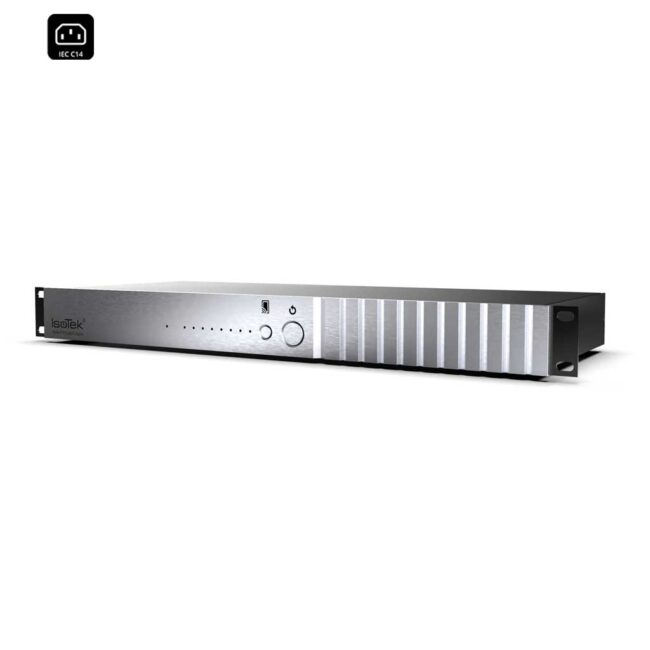
A discreet 1U (44.5mm) high rack width component. The Alpha Lite features eight C14 IEC output sockets featuring 40’000A of surge protection.
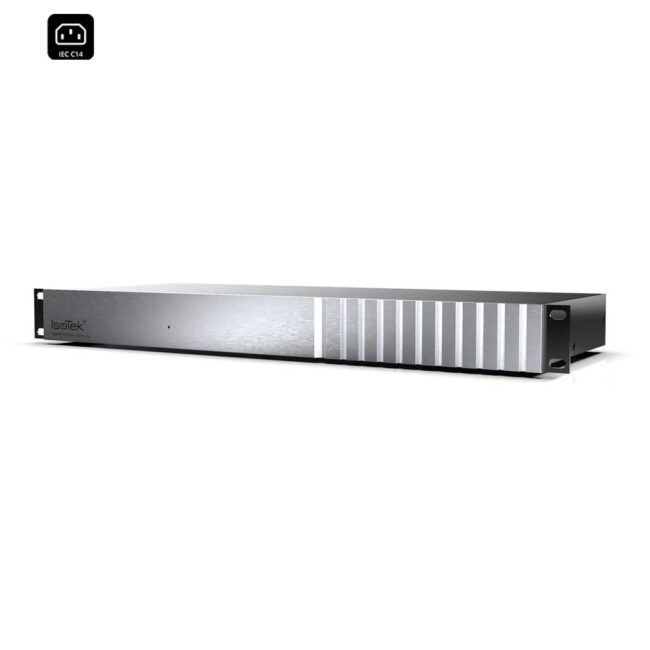
The V5 Syncro Uni 16 can be used independently for a single component, or in combination with another IsoTek power cleaner as an upgrade and to deliver a fully rebalanced sine wave across all output sockets & eliminating DC.
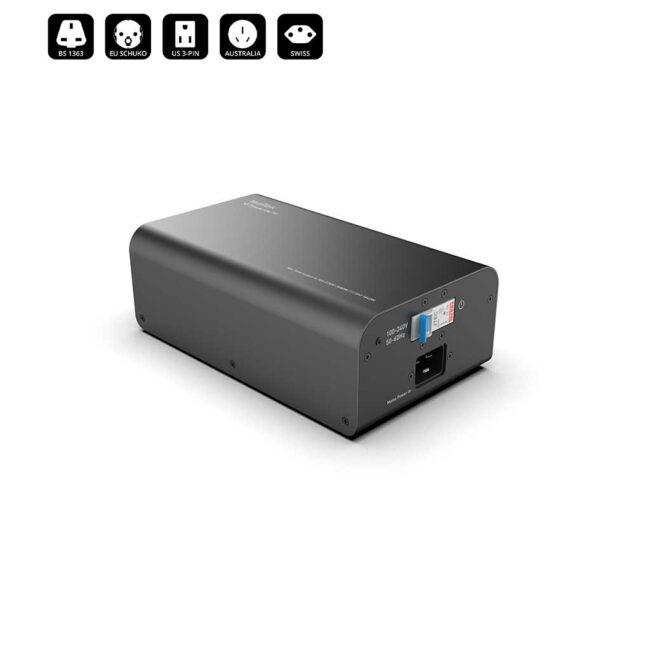
EVO3 Initium is IsoTek’s entry level power cable designed to offer high quality performance at an extremely fair price.
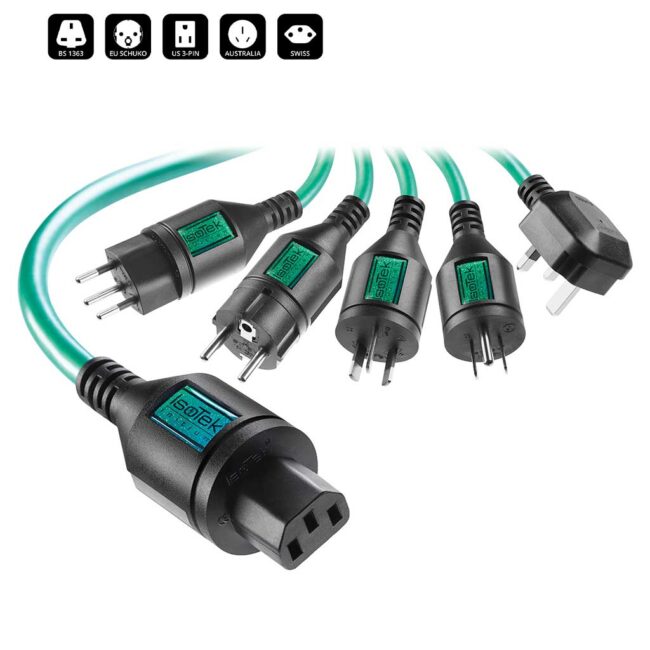
EVO3 Sequel power cable offers increased performance over IsoTek’s multi-award winning Premier, featuring optimised conductor strand geometry and active shielding.
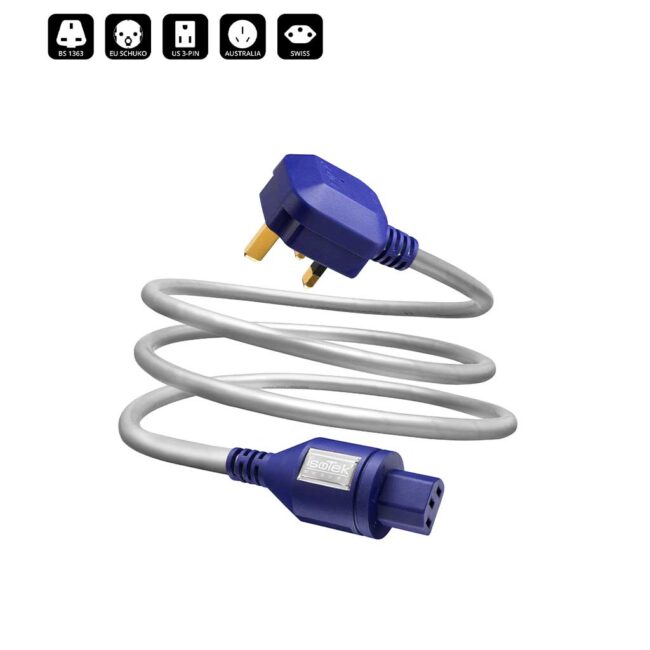
A high quality FEP provides a very low dielectric constant over a wide frequency range. The three conductors are given a slight rotational twist to aid RFI and EMI rejection, and are then surrounded by a cotton filler which give internal strength and reduce microphony.
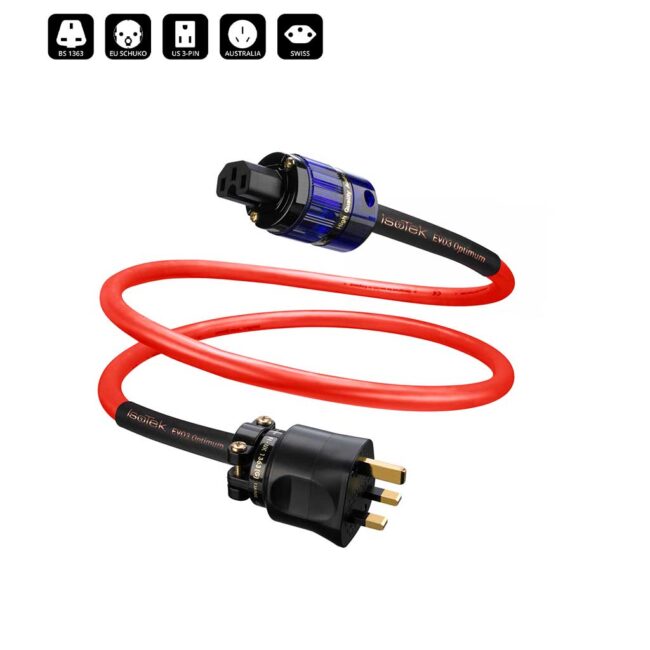
A 2U (89mm) high rack width component. The Delta Lite features sixteen C14 IEC output sockets featuring 54’000A surge protection. Input power is via 16A IEC C20 connection.
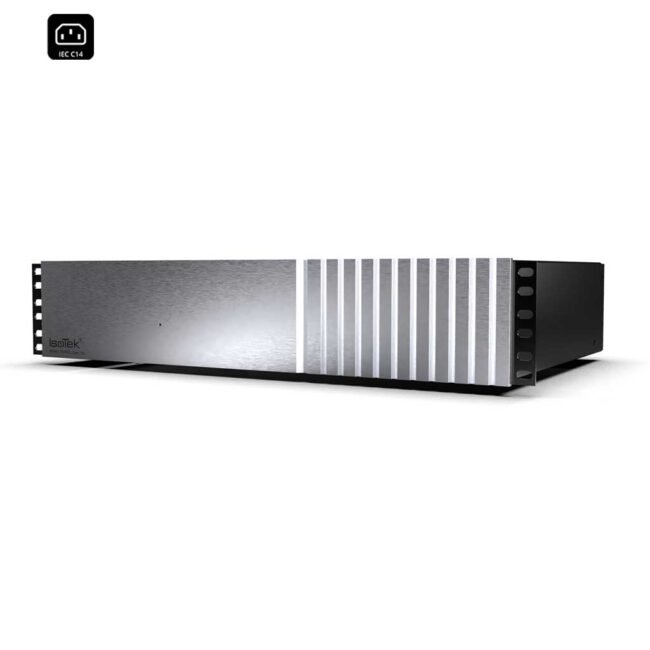
“The IsoTek SMART Delta is arguably the smartest power management system on the market. Well thought-out functions allow previously impossible processes. This achieves a new level of comfort that you would hardly live without afterwards.“
“IsoTek’s SMART Power range takes things even further, for as well as cleaning the power line, removing extraneous noise, and protecting against power surges and spikes, it offers fully programmable system power-up and shutdown.”

“This award reflects the pooled experience of EISA’s expert magazines and is a fitting tribute to the innovation and performance of this advanced mains conditioning system.”
“Power management specialist IsoTek have announced three new products that combine power cleaning with smart programmable controls. IsoTek SMART Power includes three rack mount IP controlled models: the Alpha, Beta and Theta. Each allow for full control over Wi-Fi using an app for iOS and Android, Bluetooth, LAN and RS232.”
IsoTek collaborates with trusted distributors worldwide to ensure top-quality support for its products and provide you with exceptional local service from certified professionals. Choose your country to find an authorized IsoTek supplier near you.
You need to load content from reCAPTCHA to submit the form. Please note that doing so will share data with third-party providers.
More InformationYou are currently viewing a placeholder content from Turnstile. To access the actual content, click the button below. Please note that doing so will share data with third-party providers.
More InformationYou are currently viewing a placeholder content from Facebook. To access the actual content, click the button below. Please note that doing so will share data with third-party providers.
More InformationYou are currently viewing a placeholder content from Google Maps. To access the actual content, click the button below. Please note that doing so will share data with third-party providers.
More InformationYou are currently viewing a placeholder content from Instagram. To access the actual content, click the button below. Please note that doing so will share data with third-party providers.
More InformationYou are currently viewing a placeholder content from X. To access the actual content, click the button below. Please note that doing so will share data with third-party providers.
More Information